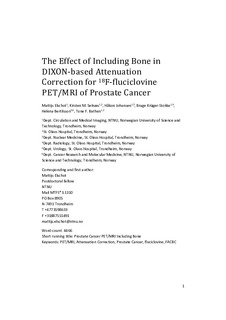| dc.contributor.author | Elschot, Mattijs | |
| dc.contributor.author | Selnæs, Kirsten Margrete | |
| dc.contributor.author | Johansen, Håkon | |
| dc.contributor.author | Krüger-Stokke, Brage | |
| dc.contributor.author | Bertilsson, Helena | |
| dc.contributor.author | Bathen, Tone Frost | |
| dc.date.accessioned | 2018-05-16T08:40:49Z | |
| dc.date.available | 2018-05-16T08:40:49Z | |
| dc.date.created | 2018-05-14T09:28:26Z | |
| dc.date.issued | 2018 | |
| dc.identifier.issn | 0161-5505 | |
| dc.identifier.uri | http://hdl.handle.net/11250/2498305 | |
| dc.description.abstract | The objective of this study was to evaluate the effect of including bone in DIXON-based attenuation correction for 18F-fluciclovine Positron Emission Tomography (PET) / Magnetic Resonance Imaging (MRI) of primary and recurrent prostate cancer.
Methods:18F-fluciclovine PET data from two PET/MRI studies - one for staging of high-risk prostate cancer (28 patients) and one for diagnosis of recurrent prostate cancer (81 patients) - were reconstructed with a 4-compartment (reference) and 5-compartment attenuation map. In the latter, continuous linear attenuation coefficients for bone were included by co-registration with an atlas. The maximum and mean 50% isocontour standardized uptake values (SUVmax and SUViso, respectively) of primary, locally recurrent, and metastatic lesions were compared between the two reconstruction methods using linear mixed-effects models. In addition, mean SUVs were obtained from bone marrow in the third lumbar vertebra (L3) to investigate the effect of including bone attenuation on lesion-to-bone marrow SUV ratios (SUVRmax and SUVRiso; recurrence study only). The 5-compartment attenuation maps were visually compared to the in-phase DIXON MR images for evaluation of bone registration errors near the lesions. P-values < 0.05 were considered significant.
Results: Sixty-two (62) lesions from 39 patients were evaluated. Bone registration errors were found near 19 (31%) of these lesions. In the remaining 8 primary prostate tumors, 7 locally recurrent lesions, and 28 lymph node metastases without bone registration errors, using the 5-compartment attenuation map was associated with small but significant increases in SUVmax [2.5%; 95% confidence interval (CI) 2.0%-3.0%; p<0.001] and SUViso (2.5%; 95% CI 1.9%-3.0%; p<0.001), but not SUVRmax (0.2%; 95% CI -0.5%-0.9%; P = 0.604) and SUVRiso (0.2%; 95% CI -0.6%-1.0%; P = 0.581), in comparison to the 4-compartment attenuation map.
Conclusion: The investigated method for atlas-based inclusion of bone in 18F-fluciclovine PET/MRI attenuation correction has only a small effect on the SUVs of soft-tissue prostate cancer lesions, and no effect on their lesion-to-bone marrow SUVRs when using signal from L3 as a reference. The attenuation maps should always be checked for registration artefacts for lesions in or close to the bones. | nb_NO |
| dc.language.iso | eng | nb_NO |
| dc.publisher | Society of Nuclear Medicine | nb_NO |
| dc.title | The Effect of Including Bone in DIXON-based Attenuation Correction for 18F-fluciclovine PET/MRI of Prostate Cancer | nb_NO |
| dc.type | Journal article | nb_NO |
| dc.type | Peer reviewed | nb_NO |
| dc.description.version | acceptedVersion | nb_NO |
| dc.source.journal | Journal of Nuclear Medicine | nb_NO |
| dc.identifier.doi | 10.2967/jnumed.118.208868 | |
| dc.identifier.cristin | 1584764 | |
| dc.description.localcode | © 2018. This is the authors' accepted and refereed manuscript to the article. The final authenticated version is available online at: http://jnm.snmjournals.org/content/early/2018/05/03/jnumed.118.208868.long | nb_NO |
| cristin.unitcode | 194,65,25,0 | |
| cristin.unitcode | 194,65,15,0 | |
| cristin.unitname | Institutt for sirkulasjon og bildediagnostikk | |
| cristin.unitname | Institutt for klinisk og molekylær medisin | |
| cristin.ispublished | true | |
| cristin.fulltext | postprint | |
| cristin.qualitycode | 2 | |
